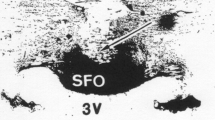Abstract
A study was made of the effects of manipulating brain dopaminergic activity upon drinking induced by intracerebroventricular administration of angiotensin II or carbachol. Non-specific lesions induced by injecting 6-hydroxydopamine (6-OHDA) into the cerebroventricles caused a significant reduction in angiotensin-induced thirst without affecting carbachol drinking. Specific 6-OHDA-induced lesions of the dopaminergic nigro-striatal pathway also attenuated the angiotensin-induced response, while unilateral lesions reduced and bilateral lesions almost completely abolished the effect. Again, the response to carbachol was unaffected. Chronic haloperidol treatment increased behavioural responses to the dopamine agonist apomorphine and significantly stimulated angiotensin-induced drinking without affecting response to carbachol. These studies provide support for the hypothesis that a dopaminergic event is involved in the angiotensin-induced thirst response and point to the need for a functioning dopaminergic nigro-striatal pathway for the full expression of this response.
Similar content being viewed by others
References
Burt DR, Creese L, Snyder S (1977) Antischizophrenic drugs: Chronic treatment elevates dopamine receptor binding in brain. Science 196:326–328
Costall B, Naylor RJ, Cannon JG, Lee T (1977) Differentiation of the dopamine mechanisms mediating stereotyped behaviour and hyperactivity in the nucleus accumbens and caudate-putamen. J Pharm Pharmacol 29:337–342
Cuello AC, Hiley R, Iversen LL (1973) Use of catechol 0-methyltransferase for the enzyme radiochemical assay of dopamine. J Neurochem 21:1337–1340
Fitzsimons JT (1972) Thirst. Physiol Rev 52:468–561
Fitzsimons JT, Setler PE (1975) The relative importance of central nervous catecholaminergic and cholinergic mechanisms in drinking in response to angiotensin and other thirst stimuli. J Physiol (Lond) 250:613–631
Iversen LL, Uretsky NJ (1970) Regional effect of 6-hydroxydopamine on catecholamine-containing neurones in rat brain and spinal chord. Brain Res 24:364–367
König JFR, Klippel RA (1963) Stereotaxic atlas of the rat brain. Williams and Wilkins, Baltimore
Muller P, Seeman P (1977) Brain neurotrasmitter receptors after longterm haloperidol: Dopamine, acetylcholine, stretonin, α-noradrenergic and naloxone receptors. Life Sci 21:1751–1758
Peres VF, Gentil CG, Graeff FG, Covian MR (1974) Antagonism of the dipsogenic action of intraseptal angiotensin II in the rat. Pharmacol Biochem Behav 2:597–602
Saller CF, Zigmond MJ (1978) A radio-enzymatic assay for catecholamines and dihydroxyphenylacetic acid. Life Sci 23:1117–1130
Seeman P, Tedesco JL, Lee T, Chau-Wong M, Muller P, Bowler J, Whitaker PM, McManus C, Tittler M, Weinreich P, Friend WC, Brown GM (1978) Dopamine receptors in the central nervous system. Fed Proc 37:130–136
Setler PE (1973) The (1973) The role of catecholamines in thirst. In: Kissiteff H (ed) The neuropsychology of thirst. Ivinstow and Sons, Washington, D.C., pp 279–291
Sumners C, Woodruff GN, Poat JA, Munday KA (1979) The effect of neuroleptic drugs on drinking induced by central administration of angiotensin or carbachol. Psychopharmacology 60:291–294
Tarsy D, Baldessarini RJ (1973) Pharmacologically induced behavioural supersensitivity to apomorphine. Nature 245:262–263
Ungerstedt U (1971) Apidsia and aphagia after 6-hydroxydopamineinduced degeneration of the nigro-striatal dopamine system. Acta Physiol Scand (Suppl) 367:95–117
Von Voightlander PF, Hosey EG, Triezenberg HJ (1975) Increased sensitivity to dopaminergic agents after chronic neuroleptic treatment. J Pharmacol Exp Ther 193:88–94
Zimmerman BG (1978) Actions of angiotensin on adrenergic nerve endings. Fed Proc 37:199–202
Author information
Authors and Affiliations
Rights and permissions
About this article
Cite this article
Sumners, C., Woodruff, G.N. & Poat, J.A. Effects of specific dopamine lesions and dopamine receptor sensitivity on angiotensin II- and carbachol-induced thirst in rats. Psychopharmacology 73, 180–183 (1981). https://doi.org/10.1007/BF00429214
Received:
Accepted:
Issue Date:
DOI: https://doi.org/10.1007/BF00429214




